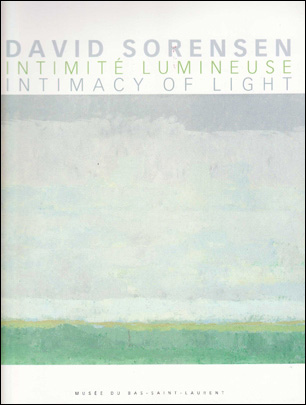2005 - A RETROSPECTIVE
THE ARTIST’S VIEW
THE MUSEOLOGIST’S VIEW
By Charles Bourget
Curator of the Exhibition
(Excerpt from 'Intimacy of Light' catalogue, 2005)
|
|

|
David Sorensen • Intimacy of Light • Intimite Lumineuse • Intimidad Luminosa by Charles Bourget, Ann Davis, , Serge Fisette, Francios-Marc Gagnon • ISBN 2-920224-37-9
|
|
|
|
My essay reviews Sorensen’s life and career in five time periods corresponding to the development of his formal and professional concerns. …
On the whole, what we wanted to show is the cohesion of the artist’s production. Each of the mediums he uses has influenced the others in a very complete creative process …
Things were going well for Sorensen at this time. In 1996, he was named to the Royal Canadian Academy, a recognition of all he had accomplished from the start of his career. Between 1997 and 1998, he pursued his figurative experimentation, which he integrated into abstract structures (p.110). In the Dialogue Series, he attempted to establish a link between different cultures, art history and the formalist concerns of Western artistic modernity. …
Retired from teaching since 2000, free to produce full time, he executed the Havana Series in 1999 (pp. 84-86), the Mexico Mixed Series in 2001 (pp. 90-91, 93), the Suite de L’Estrie in 2003, (pp. 94-95) and the Horizon Series in 2004 (pp. 97-100). He has exhibited these in Quebec, Canada and Mexico, where he still spends long periods of time…
… and Horizon Series, conceived in Mexico, and shown in five exhibition venues —Guanajuato, Torreon, Irapuato, Leon and Guadalajara - in 2004 and 2005.
VISIBLE, INVISIBLE: INDIVISIBLE
ON THE PAINTING OF DAVID SORENSEN
Text by Francois-Marc Gagnon
(Excerpt from 'Intimacy of Light' catalogue, 2005)
However, even the paintings inspired by his travels in Asia, if we go by the titles, refer to visible, often architectural structures, the very same ones he noted in his sketchbooks: a banner (Banner Series #1: Ashoka, 1991) and a flag (Japanese Flag: Seinyo No Taki, 1992) rather than a calligraphic scroll; a gate (Gate with Yellow Grid, 1992) rather than a Zen garden; a passage (Passage #3: Brown/Orange, 1991) rather than a meditative immobility. In other words, what seems to interest the artist is not so much the interior world as the outside, not so much the invisible as the visible, itself conceived as indivisible (thus not separating form from meaning, imaginary from symbolic). “The invisible becomes visible - is that a part of it … When a drop of water falls in crystal clarity, one’s vision is no longer blurred. There is an indivisible in it too. A long way yet to go but it’s there.”
And so, I maintain that the artist has stopped “bravely at the surface.” In addition, one of the Asian series’ most convincing paintings is Water Resonance (1993, p.75), which derives its basic form from the Kimono - once again an exterior surface, a covering with social significance.
SCULPTURE AS CELEBRATION
Text by Serge Fisette
(Excerpt from 'Intimacy of Light' catalogue, 2005)
But what of Sorensen the sculptor?
… sculpture takes on its true meaning in the space where it is presented …
(As with his paintings)… Sorensen’s sculptures induce this same need to act, to ask questions, except that the phenomenon is amplified …
In the early 1970s, visitors were invited to participate in a work entitled Tunnel (pp. 16, 112), exhibited outside the Musee d’art contemporain de Montreal. The action consisted of moving through a long octagonal corridor, thereby directly experiencing the sculpture. …
… the work transformed observers into actors; it led them to grasp their own sensations, each person approaching and reacting to it in their own unique way. …
The following year at Montreal’s Vehicule gallery, Sorensen pushed the concept further with a series called Rubber. The sculptures were made of flexible rubber sections that could change shape through the active participation of the spectators, whose efforts created new forms and rhythms. Here on the floor were long bars that could be manipulated; there, an enormous Flexible Cube (p.17) more than two metres high. Viewers could enter the cube and, by grasping the vertical edges, change its shape or even cause audible vibrations. No directions were given; each person did whatever their mood and creativity prompted them to do, playing with and undoing the perfect cube, which had become on this occasion a soft and moving sculpture, a toy, a playful space where, as Sorensen said, humour offset the rigid hard edge of minimal art then in vogue. “I wanted to break away from minimal geometric cubes, break up the perfect structure.” …
It was certainly a sense of calm and solidity, of “tensions resolved”, that many people felt in the 1986 sculpture Displaced Arc, which the artist installed in the central pavilion of the University of Sherbrooke, under Quebec’s “1%” Program for the Integration Art and Architecture (p.26). Placed directly on the floor, crossing the entrance hall with a length of almost eleven metres, the imposing curved structure of laminated wood seemed to support the ceiling by holding up a gigantic aluminum beam at one end. As with a number of his other works, Sorensen invited viewers not simply to contemplate the work but to “use” it, to straddle it, sit on it, touch it, place themselves in relationship to it, measure themselves and the surrounding space against it, a space enlarged beyond measure by the installation, for it created the impression that the arc continued onto the floor above, beyond the ceiling, where a painted addition encouraged viewers to look up.
Back to Catalogues Menu |
